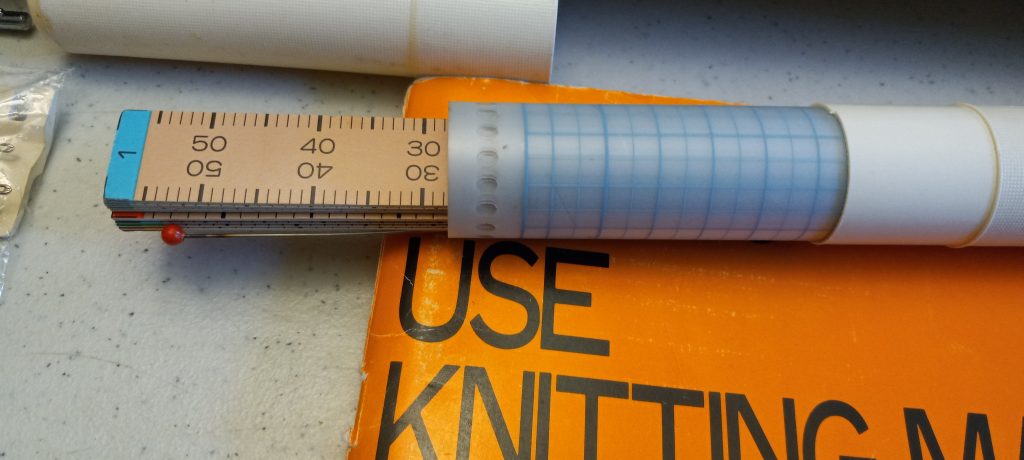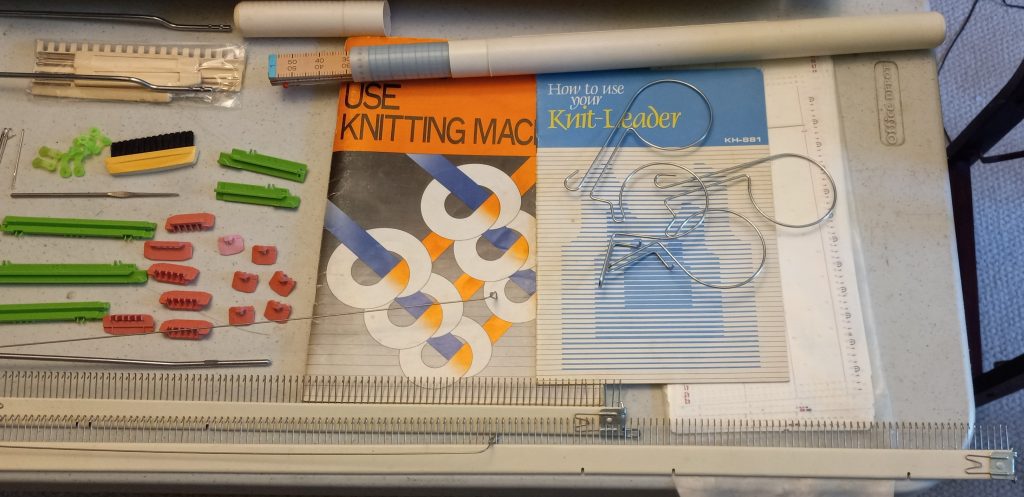Brother KH881 knitting machine is a standard gauge machine with 200 needles, 4.5 mm apart. It appeared on both Western and Japanese markets in the late 1970s. The model for the Japanese markings (with the writing in Japanese) is often accompanied by the Palie 8 nickname. In North American markets, it was also released under the KnitKing KH881 name.

Brother KH881 was one of the first (probably after Brother KH871 model released for Japanese markets only) Brother knitting machine with a built-in knit leader. (It’s interesting, that Singer/Silver Reed/Studio were making knitting machines with knit-leaders almost a decade prior). Thus, among other accessories, tools needed to chart shapes and garments are included with standard setups.


Independent on the market and on the name, KH881 has a very typical greenish color combination, which makes this machine stand out.

KH881, similar to other punch-card knitting machines manufactured by Brother, can pattern automatically using punchcards, inserted into a punchcard reader, which can be purchased from my store.
The maximum repeat pattern is 24-stitch. Thus, punch cards have 24 holes in a row. The punchcard reader translates the pattern to the needle selection mechanism. Using knobs, levers, and buttons on the carriage, various patterns (like tuck, slip, weave, lace, and fair-isle) can be created.
Unlike some other Brother knitting machines, KH881 does not have a built-in toolbox because the knit leader takes a lot of space. However, the stand-alone toolbox is very compact and fits all minor tools without problems. The box sits on the needle bed right next to the carriage when the machine is in storage.

Unlike other punchcard-capable knitting machines, Brother KH881 (and other machines with built-in knit leaders) has a built-in row counter (not detachable).

The main knob on the carriage has N-L, KC, SM and CR positions. The patterning capabilities are activated when the knob on the carriage is moved into the KC position and the carriage latches onto a timing belt. A timing belt also helps (if oiled well) to move the carriage more easily across the bed. The handle on the carriage folds when not in use.

I like the position of the settings on the knob on this model a bit better than on its previous counterparts (like KH830): the first is NL position (plain knit), then single motif (SM) and then carriage release. It makes sense to me to make the carriage release setting last. However, KH830 has a “carriage release” setting first. However, it is simply a matter of comparison and a habit. Often knitters do not have the luxury to knit on several machines and settle with whatever machine they can get. Thus, whatever a knitter is used to determines their preference. Brother KH881 comes with a standard set of minor and major accessories. The major accessories that are expected to be included are extension rails, cast-on combs, punchcards, and lace carriage. Together with the mast, they fit into the lid of the case when not in use.
The carriage has tuck, fair-isle (middle MC button), and part (for slip-stitch knitting) buttons as well as N/H and plain levers. Patterning is activated by attaching the carriage to the timing belt by turning the knob on the carriage to KC position. CR and NL positions of the knob on the top right-hand side of the carriage are for “no-patterning” and “carriage” release functions. Unlike its earlier counterparts (Brother KH830 and KH836) and similar to Brother KH840, and KH860, KH881 has an additional setting on the change knob: SM, for single motif knitting. The manual explains how to knit single motifs using single motif accessories (long green bars), which are also included with the standard setup.
The sinker plate has a two-thread yarn holder. A standard mast is also capable of handling two different yarns at the same time.

The features and capabilities of Brother KH881 are very similar to those of KH840, KH860 and KH890 (with the very minor exception of the capabilities with various Garter Carriage models). Some KH860 have built-in garter carriage rails but KH881 does not.

The minor accessories are stored inside a stand-alone box with a lid. These minor accessories include transfer tools, extra needles, selection comb, claw weights, carriage lock, table clamps, etc. Brother KH881 is also equipped with an extensive set of single motif accessories similar to Brother KH890 but unlike its earlier punchcard counterparts (Brother KH830 and KH840). Like most Brother punch-card knitting machines, comes with a punch-card holder rod. However, I often forget to insert it and use the punch card reader without that rod and without any problems. I even feel that because the machine knits and patterns without this rod/pin, this pin gets lost and overlooked so often. Other accessories include a plating feeder and a set of single motif cams.

The toolbox latches to the needlebed for storage when not in use.
Similarly to all other Brother punchcard machnes, the retaining bar is metal but contains a sponge strip, which needs to be replaced every 6-12 months. The retaining bar with this sponge holds the needles in place. Without the retaining bar, the needles will be too wobbly and will lose stitches. The retaining bar is 0.5 inches wide and 41 inches long.

Table clamps are more modern and are simple clamps without any bolt-like screws like more vintage models. Notice that this type of clamp for Brother machines somewhat differs from similar clamps for Singer/Studio/Silver Reed machines: there is no protruding top bracket in Brother knitting machines. Both the top and bottom panels are on the same level.

I had the pleasure of working on Brother KH881 (see a video of my tests and a blog article dedicated to the tests of that particular Brother KH881). It is a solid machine and despite being so vintage, it will still work for many years especially if kept in a controlled environment and serviced (cleaned and oiled) regularly.
Like most punch-card Brother knitting machines, Brother KH881 is compatible with the following add-on accessories:
- Ribbers: KR810, KR830, KR850, KR900, RK900
- Color changers: KHC820A, KRC 830, KRC900, KRC 1000E, KRC-1100M
- Garter carriages: KG88 and KH88II.
- Transfer carriage: KA8300
- Intarsia carriage: KA8210
Pros and Cons of Brother KH881 knitting machines:
PROS:
- The number one advantage of this machine among more typical punchcard knitting machines is a built-in knit leader.
- Solid machine with plenty of replacement parts on the used and new market.
- Plenty of resources online on how to use it.
- The row counter is built-in
- Automatic patterning with slip-, tuck- and fair isle stitches. Just insert the punch card and knit away. Can do weaving.
- Can handle two different yarns (of different colors, for example) at once without the need for a color changer.
- Compatible with a variety of add-on accessories like ribber, transfer carriage, garter carriage, etc.
- A timing belt when using the machine in patterning mode makes the carriage slide a bit easier.
- The punchcard reading mechanism has an option to expand the pattern two times.
- Very well-written manual. There is a separate manual on how to use the knit leader.
- The handle on the carriage folds nicely (on some older models it screws on) for storage. Almost zero chance for the handle to be misplaced or lost.
- Comes with the plating feeder, which is not included in standard setups in earlier punchcard models, like KH830 and KH836.
- Comes with single motif settings and accessories, which were not included in standard setups in earlier punchcard models, KH830 and KH836.
- Stand-alone accessory storage box
- Additional settings on the carriage (SM setting on the change knob on the carriage), not previously available on earlier punch-card knitting machines, like KH830 and KH836.
CONS:
- The toolbox is not built-in. However, I still like how compact it is and it sits nicely on the needle bed when the machine is in storage.
- The garter carriage rails are not built-in on most machines
- The repeat pattern is limited to 24 stitches. If you want more flexibility, electronic patterning (KH9XX series) machines is the way to go.
- The sponge bar needs to be replaced regularly.
- If not stored/taken care of properly, it will rust.
- Buttons on the carriage are often stuck if the machine is not in use for prolonged periods of time.
- The standard set of punch cards is somewhat limited. Knitters who want other designs will need to punch their own (a quite tedious process if done by hand and a step-learning way if done by Cricut or similar automatic cutters).
- Again, only if not used for prolonged times, the patterning mechanism might start misbehaving… The reasons might be: gunk/dirt, stuck pieces of yarn, incorrect engagement with the timing belt, incorrectly (too thick) selected yarn/tension, faulty needles, etc.
- Plastic components of the machine, including plastic parts on the carriage, end caps, and others are prone to discoloration due to exposure to sunlight even through the window. Thus, please cover your machine with a thick curtain or a towel to prevent further sun damage.
- Not capable of knitting thread lace.
If you are deep-cleaning your Brother knitting machine with a built-in knit-leader, check out this video on how to remove the knit leader from the case.

Other standard Brother knitting machines with 24-hole punch-card capabilities and built-in knit leaders are KH871, KH891, KH893.
I would recommend the Brother KH881 machine to any knitters: beginners and advanced, hobbyists, artists, and even small business production.

